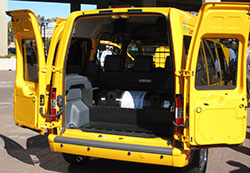Vehicle Conversion Basics

A Ford Transit Connect converted to run on compressed natural gas.
A converted vehicle or engine is one modified to use a different fuel or power source than the one for which it was originally manufactured. This includes converting a gasoline- or diesel-powered vehicle to run on propane, natural gas, ethanol-gasoline blends containing up to 83% ethanol, or battery power.
Dedicated, Bi-Fuel, and Dual-Fuel Conversions
Vehicles and engines can be converted to "dedicated" configurations, where they operate exclusively on one alternative fuel. They can also be converted to "bi-fuel" configurations where they operate on either of two fuels that each have separate tanks and fuel systems—one for conventional fuel and another for an alternative fuel. In this case, either fuel can be accessed by simply flipping a switch. Although U.S. Environmental Protection Agency regulations refer to bi-fuel configurations as “dual-fuel,” this term typically refers to a third type of configuration where two fuels are used together. For example, a heavy-duty natural gas vehicle that uses a small amount of diesel fuel for ignition assistance is a dual-fuel system.
Repower
A process that involves removing a vehicle’s original engine and replacing it with a new engine or power source (such as an electric drive system). Because new engine components and older vehicle engine compartments are not designed for one another, repowering a vehicle requires an engineered solution.
Conversion Systems Installation
When you purchase an alternative fuel vehicle through a dealership, the conversion system is installed by the system manufacturer or by a qualified system retrofitter (QSR) who meets National Highway Traffic Safety Administration and/or California Air Resources Board requirements, as well as National Fire Protection Association (NFPA) code 58 (for propane) and NFPA code 52 (for natural gas), in order to convert original equipment manufacturer vehicles. When converting an in-service vehicle, the work should always be completed by a technician associated with a QSR, also referred to as an upfitter or installer, who is associated with a manufacturer and holds all relevant emissions-related certifications, tampering exemptions, and permissions. Ford's Qualified Vehicle Modifier program is an example of a QSR.
Converting, retrofitting, or repowering a vehicle can result in long-term return on investment while helping fleet managers achieve sustainability goals. To learn about technology options and considerations for fleets pursuing a vehicle conversion, as well as best practices for selecting and working with project partners, service providers, and reputable vendors, see the report What Fleets Need to Know About Alternative Fuel Vehicle Conversions, Retrofits, and Repowers.